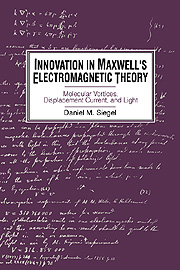Book contents
- Frontmatter
- Contents
- Preface
- Introduction
- 1 The background to Maxwell's electromagnetic theory
- 2 Mechanical image and reality in Maxwell's electromagnetic theory
- 3 The elaboration of the molecular-vortex model
- 4 The introduction of the displacement current
- 5 The origin of the electromagnetic theory of light
- 6 Beyond molecular vortices
- Conclusion
- Appendix 1 Draft of “On Physical Lines of Force,” a fragment
- Appendix 2 Drafts of “A Dynamical Theory of the Electromagnetic Field”
- Appendix 3 Vortex rotations in a curl-free region
- Notes
- Index
5 - The origin of the electromagnetic theory of light
Published online by Cambridge University Press: 24 October 2009
- Frontmatter
- Contents
- Preface
- Introduction
- 1 The background to Maxwell's electromagnetic theory
- 2 Mechanical image and reality in Maxwell's electromagnetic theory
- 3 The elaboration of the molecular-vortex model
- 4 The introduction of the displacement current
- 5 The origin of the electromagnetic theory of light
- 6 Beyond molecular vortices
- Conclusion
- Appendix 1 Draft of “On Physical Lines of Force,” a fragment
- Appendix 2 Drafts of “A Dynamical Theory of the Electromagnetic Field”
- Appendix 3 Vortex rotations in a curl-free region
- Notes
- Index
Summary
The molecular-vortex model provided the context for the first appearance of both the displacement current and the electromagnetic theory of light. The first form of the electromagnetic theory of light – which differs from the modern form no less than the first form of the displacement current differs from its modern counterpart – appeared in Part III of “Physical Lines,” published in January 1862. In brief, the newly introduced elastic property of the magnetoelectric medium allowed for the propagation of transverse shear waves in that medium; calculating, from the parameters of the model, the velocity of such waves – and finding close agreement with the measured velocity of light – Maxwell identified these waves in the magnetoelectric medium as light waves, and he concluded that the magnetoelectric and luminiferous media were one and the same. The broad nineteenth-century background bearing on such a connection between electromagnetism and light is taken up in Section 1 of this chapter. Section 2 then broaches the question of the precise role of the molecular-vortex model in the origin of the electromagnetic theory of light: Was the electromagnetic theory of light, as textbook accounts might suggest, from the outset basically a matter of deriving wavelike solutions from the equations of electricity and magnetism – in which case the mechanical model could have played at most an ancillary role in the genesis of the theory – or did the molecular-vortex model in fact play a more essential role in the initial formulation of the electromagnetic theory of light, as suggested by the fact that the theory made its first appearance in Part III of “Physical Lines”?
- Type
- Chapter
- Information
- Innovation in Maxwell's Electromagnetic TheoryMolecular Vortices, Displacement Current, and Light, pp. 120 - 143Publisher: Cambridge University PressPrint publication year: 1992



